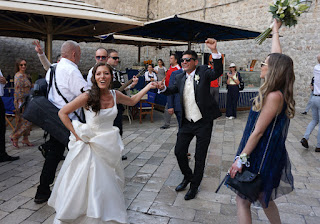September 29, 2022
September 29, 2022
We left Plitvice National Park, Croatia, heading north. It is raining again. The terrain of rolling hills looks a lot like Kentucky or southern Illinois. Once we reached the highway we followed it west to Opatija at the beginning of the Istrian Peninsula that extends into the Adriatic Sea. Opatija, which comes from the Croatian word for Abbey, was known as Monte Carlo of the Adriatic. It was the playground of the rich in the Austro-Hungarian Empire. The nearby port of Rijeka was important to the Austrian Navy and later the Yugoslav counterpart. Aimee and I stopped at a cafe on the waterfront to people-watch before strolling the promenade that goes over and around the many hotels and restaurants facing the sea. We admire the Austrian era architecture.
Back on the road we quickly cross the border into Slovenia, another remnant country of the old Yugoslavia. It is one of the smallest but the richest. It joined the EU years ago and now uses the Euro. I can already tell prices are higher here than Croatia. Our next stop is at Postojna Cave Park. The Karst mountains here are full of caves. Postojna is the largest and has been open for tourism for over two centuries. It is very popular. I can’t believe the crowd here. Aimee and I first stop for a light lunch.
Once in the cave our guide loads us on a little electric train that carries us a two miles down a shaft filled with cave decorations. Surprisingly the cave is dripping with rain. We are shocked that the rain has caught up to us, on an indoor tour! But I guess that is how stalactites and stalagmites form, from rain that drips through cracks in the rock. The rain collects and exits the cave system in the form of a raging river that eventually flows into the Sava and Danube Rivers.
We get off the train and walk a mile-long loop trail. Aimee is amazed that the concrete ramp is not slippery even though it is covered in water. The trail climaxes in an area called Paradise. At least paradise for cave aficionados. This section has a white ceiling of ‘soda straws’. They glow almost like crystals. Interestingly, the guide mentioned that these are the longest in the world after our very own Kartchner Caverns in Tucson. It is a small world!
Leaving Postojna, we drive through pouring rain and construction north past the Slovenian capital of Ljubljana into the Julian Alps, where we stop for the night in the resort town of Bled on its eponymous Lake.
We left Plitvice National Park, Croatia, heading north. It is raining again. The terrain of rolling hills looks a lot like Kentucky or southern Illinois. Once we reached the highway we followed it west to Opatija at the beginning of the Istrian Peninsula that extends into the Adriatic Sea. Opatija, which comes from the Croatian word for Abbey, was known as Monte Carlo of the Adriatic. It was the playground of the rich in the Austro-Hungarian Empire. The nearby port of Rijeka was important to the Austrian Navy and later the Yugoslav counterpart. Aimee and I stopped at a cafe on the waterfront to people-watch before strolling the promenade that goes over and around the many hotels and restaurants facing the sea. We admire the Austrian era architecture.
Back on the road we quickly cross the border into Slovenia, another remnant country of the old Yugoslavia. It is one of the smallest but the richest. It joined the EU years ago and now uses the Euro. I can already tell prices are higher here than Croatia. Our next stop is at Postojna Cave Park. The Karst mountains here are full of caves. Postojna is the largest and has been open for tourism for over two centuries. It is very popular. I can’t believe the crowd here. Aimee and I first stop for a light lunch.
Once in the cave our guide loads us on a little electric train that carries us a two miles down a shaft filled with cave decorations. Surprisingly the cave is dripping with rain. We are shocked that the rain has caught up to us, on an indoor tour! But I guess that is how stalactites and stalagmites form, from rain that drips through cracks in the rock. The rain collects and exits the cave system in the form of a raging river that eventually flows into the Sava and Danube Rivers.
We get off the train and walk a mile-long loop trail. Aimee is amazed that the concrete ramp is not slippery even though it is covered in water. The trail climaxes in an area called Paradise. At least paradise for cave aficionados. This section has a white ceiling of ‘soda straws’. They glow almost like crystals. Interestingly, the guide mentioned that these are the longest in the world after our very own Kartchner Caverns in Tucson. It is a small world!
Leaving Postojna, we drive through pouring rain and construction north past the Slovenian capital of Ljubljana into the Julian Alps, where we stop for the night in the resort town of Bled on its eponymous Lake.




















































